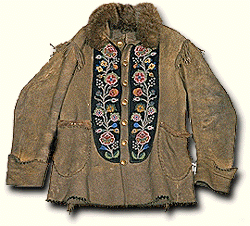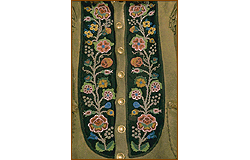
![]()
Riel's Deerskin Coat

Métis; ca. 1885. CMC E-111
Floral designs on articles made by the Indigenous people of the northern forests were once thought to be traditional native motifs. Yet, such patterns are seldom seen on items made before 1800, and were never present in prehistoric native art expressions.
The design on this deerskin coat represents European flowers in a composition that is reminiscent of colonial folk art. This influence is not surprising when we consider that Ursuline nuns in Québec in the mid-1600s had started mission schools in which they instructed native girls in the art of embroidery. Truly floral art had its genesis in the Great Lakes region in the late eighteenth century. There, Métis women living at missions and fur trade posts integrated realistic floral designs into their pictorial vocabulary. By the time the Métis had settled on the Red River, their floral artistry was so distinctive that they came to be called the Flower Beadwork People by the Indians of the region.

Decorated with a beaded embroidery design common among the Métis, this deerskin coat is reported to have belonged to Louis David Riel (1844-1885). A complex man, Louis Riel is today regarded by some a hero who personified the aspirations of Western Canada's Métis. In 1885, however, after leading the Red River Rebellion, he was judged a traitor and was hanged.
